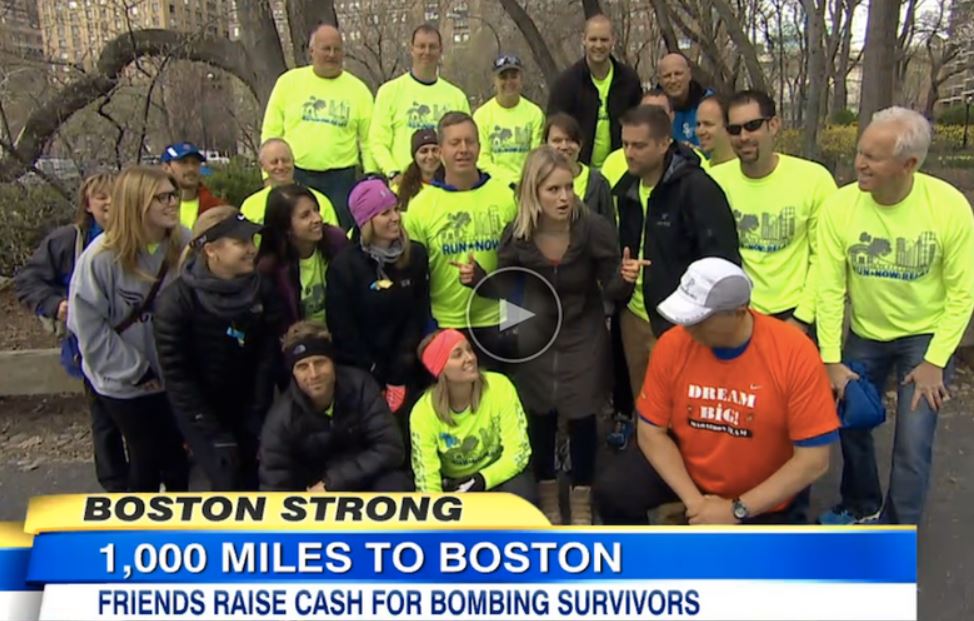By Clark Campbell, {grow} Community Member
It’s true.
I got my team on Good Morning America through a Twtter strategy. Massive exposure through Twitter! And while I can’t guarantee it would work for everyone, I think this approach to using Twitter for media relations is scalable for other PR projects. Here’s our story.
#Backstory
Run Now Relay was conceived in the spring of 2013 following the Boston Marathon Bombings. Our local running community decided to hold a 5K charity event to raise money for victims of the tragedy. I volunteered my time to help get the word out on Twitter and Facebook.
It was a great success and we raised nearly $64,000 for the good people of Boston.
In a follow-up meeting, the group discussed creative ways to deliver the funds raised and someone jokingly spouted off, “let’s run the money to Boston as a show of solidarity to the people of Boston and the running community as a whole.”
The rest is history.
#Preparation
As we prepared our media efforts for the 1,000-mile run, we sent an email introduction to every media outlet in major cities between Tennessee and Boston. A few replied but most didn’t. Even the local stations were cool to the story.
So, we made a list of social media accounts for news affiliates and newspapers up the East Coast. We found some of their Facebook pages but found ALL of their Twitter handles. It seemed like using Twitter for media relations was going to be the best way to connect with reporters over the course of this long run.
#Boom
One week before the run from Tennessee to Boston we began leveraging Twitter to communicate with our Chattanooga ABC affiliate, WTVC. We didn’t start with the station’s Twitter handle, we went right to the reporters and the anchors.
The momentum started when @NewsChannelNine Saturday morning anchor/producer, @LaurenStNC9 replied immediately with a sense of awe for what we were doing. She reached out to me via DM, then via email, and then via cell phone (follow the breadcrumbs to the news desk, right?).
She pitched a featured Saturday & Sunday story to her News Director and before we could blink they agreed to air the story. Within a few days they were taping interviews and building the weekend package to be aired the day we left for Boston.
It got even bigger when they decided that a live truck and reporter would be ideal for the weekend story. Not only did they tell our story on launch day, but they also followed us online, interacted with us daily on twitter and ran news updates almost every day of the 8-day journey to Boston.
#Momentum
The local support gave us the confidence and the momentum to think more strategically about our media opportunities. We had a little success but could we cut through the noisy world of Twitter to scale our success?
From the very beginning, one huge goal was to tell the #RunToBoston story on either Good Morning America, NBC’s Today Show, or Fox & Friends as our team passed through Manhattan. But we knew that we had to appear on local affiliates along the way to grab the attention of the national media.
We were not going to blitz the network news show Twitter accounts. We would produce subtle waves on social media that would build by the time we arrived in New York City.
#LetTheGamesBegin
We departed Tennessee and our three person media crew slept an average of four hours a night for seven nights. We worked all day long in the confines of our media vehicle, a Ford Escape SUV. We utilized three iPhones, two iPads with mobile hotspots, two MacBooks and we had more USB charging cables than we could count.
On the very first day we discovered that contacting news affiliates via email or Facebook pages didn’t work. But starting conversations on Twitter worked almost every time. We also learned these four things:
- A simple search on Twitter for, “news [insert city name]” immediately gave us affiliate Twitter handles, but more important, dozens of anchors, reporters & journalists. So, we reached out to each one individually with a short statement about our cause and a link to our press page for more information.
- Reaching out to these reporters early in their shift change was most effective because they were looking for a great story with immediacy and relevance.
- We rarely, if ever, received replies from media brand channels. Reporters, anchors producers and journalists almost always favorited, followed, replied, or RT’d our touch points.
- The further we got from Tennessee the more momentum we gained landing TV news interviews with runners. (Knoxville – 1, Bristol – 1, Roanoke – 1, Charlottesville – 2, Baltimore – 3, New Jersey/New York – 2, Boston – 2.)
Massive exposure through Twitter
As we arrived in New York, a national TV appearance still seemed like a remote possibility.
I convinced our runners to get up early and head out to the Good Morning America studio by 6 a.m.. We all stood on the front row outside GMA. We got a shoutout on the program from one of the hosts but more important, we had their attention. We had been connecting via Twitter the day before with one of the show’s producers and we finally received a call, asking us to meet him in Central Park in one hour to tape a segment.
We had achieved our goal — A feature story on Good Morning America!
#TheNumbers
$64,000 raised for charity
1,075 miles run to Boston
26 runners
15 media Interviews
9 states
8 days
1 Great Success Story. Massive exposure through Twitter.
 Clark Campbell is the founder of BenjaminClark Productions. His company specializes in amplifying event conversations on social media to maximize exposure.
Clark Campbell is the founder of BenjaminClark Productions. His company specializes in amplifying event conversations on social media to maximize exposure.



